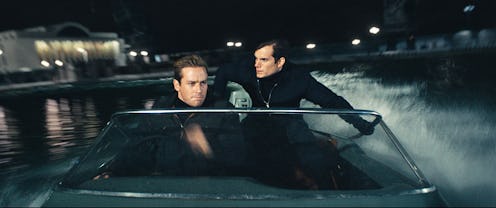Entertainment
How 'Man From U.N.C.L.E.' Compares To The TV Show

The Man From U.N.C.L.E. star Henry Cavill has been called the next James Bond for his role as spy Napoleon Solo in the film update of the classic ’60s television show — fittingly, since Bond creator Ian Fleming played a role in the development of the original series. The Man From U.N.C.L.E. of 1964 was, as The Guardian points out, actually created as a US-made response to the British spy. Though the new film owes quite a lot to the original series, it charts its own route through the politically fraught Cold War era. The film strays from the television show enough that viewers unfamiliar with the original series will still follow its twisting intrigue and get its nods to other spy satires. But where does the film really diverge from the television show — how does The Man From U.N.C.L.E. compare to its TV show?
Henry Cavill told ABC that he did not familiarize himself with the show before embarking on his performance as Napoleon Solo — "I don't like the idea of potentially stealing someone else's performance," he said. Though the movie features mod fashion and its technology seems straight out of a 20th-century spy caper, it does not have the gritty aesthetic of a period piece. Instead, it's all polish and shine, adding a smooth veneer to the original series. Just as Terminator Genisys attempted to do for the original Terminator films and Star Trek: Into Darkness aspired to do for Captain Kirk and crew, The Man From U.N.C.L.E. uses its source material as inspiration, rather than attempting to re-create it wholesale for a contemporary audience. Here's how.
1. A New Score By Daniel Pemberton
Jerry Goldsmith wrote the theme song for the original series, whose soundtrack came to be as well known as the show itself. The Man From U.N.C.L.E. spawned hours of music, but filmmakers elected Daniel Pemberton to compose a new score for the film. Influences of the original theme song can be heard in the opening credits.
2. New Technology, New Gadgets
The "let's disarm [insert nuclear device here]!" plot is a pretty tired one, as far as action flicks go. Though the technology that drives the plot is a familiar one, the gadgets the spies possess are almost all updates on the classic series, which boasted U.N.C.L.E. badges and communicator pens. They're abandoned in favor of tracking devices and tiny bugs (Illya and Solo compare attempts to bug each other in one comical scene). When the two break into an aeronautics factory operated by a suspected Nazi, Solo uses boron wire cutters sharpened with a "CO2 laser" to cut through the fence — while Illya goes the short route, slicing through the chain-link fence with the laser itself. The gadgets are still suitably analog for the ’60s, but they still get a bit of a contemporary overhaul.
3. Cold War Tensions Never Boil Over
The 1964 series fails to explain how a Soviet and American spy could be coming to work on the same team, but it does result in some interpersonal drama. In the film, after a few spars at the outset, Illya and Solo fall into a competitive but ultimately friendly partnership (symbolized when they burn the disk they've both been tasked with retrieving, instead of killing each other over it, at the film's close). Aside from the occasional glib remark, there's very little in the way of ideological tension between the two.
4. An Homage Rather Than A Remake
A fight scene toward the end of the film, when the two spies take down the obstacles en route to a secret island where Gaby is held captive, appears in a several-minutes-long split-screen montage, a clear nod to the camp of the original. As a sort of satire-of-a-satire, The Man From U.N.C.L.E. bows to not only the television series that inspired it, but the other espionage satires that made it possible (not the least of which is the aforementioned Bond).
5. THRUSH No More
U.N.C.L.E.'s original arch-nemesis was an organization known as "T.H.R.U.S.H." In this film, at least, this was abandoned in favor of the fascist Vinciguerra dynasty (helmed with cold calculation by Victoria Vinciguerra, a statuesque Elizabeth Debicki). "I’m not sure if THRUSH meant the same thing," Guy Ritchie said of the original series, according to Games Radar — perhaps it was in their best interest to change it up here.
6. Alicia Vikander's Character Gaby
In the final season of The Man From U.N.C.L.E., Barbara Moore joined the cast as Lisa Rogers — a lone female recurring role in what was essentially a boys show. The film, however, offers us Gaby Teller, played with sass and a bit of self-seriousness by Alicia Vikander. Though she begins as a plot point, it eventually becomes clear that Gaby will be sticking with the Solo-Kuryakin team as a third member of U.N.C.L.E.
The Man From U.N.C.L.E. film has been nearly two decades in the making, with names rumored to be attached including Quentin Tarantino, John Hamm, and George Clooney. And even before the struggle to get a film made, there was the pressure of basing a movie on a much-loved and oft-cited television show. Yet, as director Ritchie told Games Radar, "It was a totally clean slate" when he came onto the project. He aimed to present a sort of prequel to the series, to answer the questions that went unresolved in the show and to provide a background for a potential franchise to come — and it's definitely coming, if the closing scene is any indicator.Images: Warner Bros. Pictures (6)